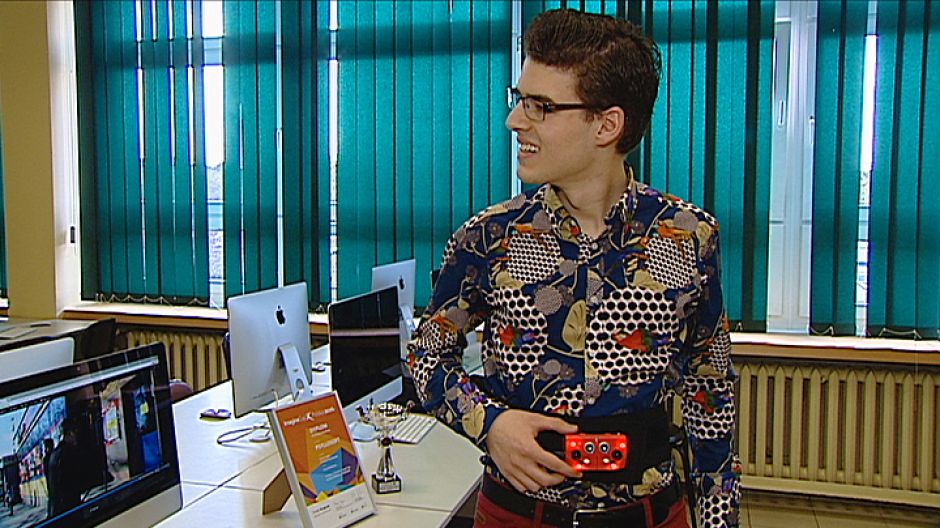The Polish Student Creating Artificial Eyes for the Blind [Culture.pl]

for: Culture.pl
Petros Psyllos, a Polish computer science student, has created a revolutionary device called MATIA that serves as an ‘artificial eye’ for the blind. Equipped with a camera and many sensors, it sees the world and helpfully describes it with words as well as melodies. Unsurprisingly, the young inventor, with this and his other noteworthy creations, has already been making a name for himself with the likes of Microsoft.
A young Homer in Białystok
Some say that Homer, the great ancient poet born on the island of Chios, was blind. Quite interestingly, Petros Psyllos, a Polish computer science student with roots from the same Greek island, is making a name for himself with two inventions that are making life easier for those who can’t see.
MATIA is, for want of a better word, an eye opener – equipped with a camera and fourteen sensors, this small, wearable device provides verbal and sound descriptions of its surroundings. Neutrognet, on the other hand, is a sort of smart-thimble you can use to operate a smartphone without touching it or taking it out of your pocket – it provides a realistic solution to the problem of blind people being robbed of electronic devices in public places.
Even though Petros’ parents are Polish and Greek, he calls himself a Polish inventor because he spent most of his youth and was educated in Poland. He lives with his folks in the eastern city of Białystok, where he also follows an individual course of study at the local University of Technology.
Writing on an invisible blackboard
As a teen, Petros became fascinated with neuroscience, and aged 19 he came up with the idea of a glove that turns the gestures of sign language into synthesizer-generated speech. He soon created the impressive device as a means of aiding the mute, while professing cheekily that it reminded him of something from The Terminator. The glove went on to win first prize at the 2013 Brussels Innova exhibition for new technologies and inventions.
In 2014, he presented Neutrognet, a far handier piece of equipment meant for the blind. The thimble-like object you put on your finger is small and light enough to be worn all day. Via its Bluetooth connection, any gestures you make with it can operate smartphones, tablets or other electronic devices without having to physically touch them. The device communicates with its operator through a voice interface. It can even send a text message just by waving your finger around in the air. Writing with it is intuitive, because it’s like writing with a piece of chalk on an invisible blackboard.
The device solves two major problems that plague blind people. Firstly, it lets them text in loud places where voice recognition systems don’t work properly. Secondly, it lets them use their phone or tablet without taking it out of their pocket or bag, thus reducing the risk of theft. This is particularly useful since, unfortunately, the blind often have their electronic devices stolen from out of their hands in public areas. If all goes to plan, Neurognet should mean a massive reduction in such disheartening behaviour.
The eye that speaks the language of the blind
After Neutrognet, the Polish wunderkind created MATIA, another device meant for the blind. This wearable ‘artificial eye’ is a small box you can attach to your shirt that provides you with verbal descriptions of what’s in front of you. How is this possible? The thing is equipped with a camera and fourteen sensors (e.g. one that analyses incoming sounds) and sends all the information they pick up to your smartphone where a dedicated AI app synthesizes it all.
Using all this info, MATIA tells its user what it can observe, using everyday sentences constructed from a large bank of words. For example, it can say in a human voice: ‘One person in front of you’. It can also tell you if there’s an obstacle in your way and what are the denominations of the banknotes in your palm. But there’s more. Petros claims that MATIA can even read people’s facial expressions and provide you with a warning when it looks like somebody’s up to no good.
A really nice touch is that MATIA can communicate with its user through sound signals or melodies, saving the time required for verbal descriptions. For example, the sound of an alarm siren can stand for an obstacle, and a given melody can substitute a particular sequence of words. This function is highly configurable so that each user can have his own set of signals and melodies that best suits him or her.
The fact that such a function is included in MATIA shows that its creator has a good understanding of the blind man’s world. In the brain of a person that can’t see the part normally responsible for vision turns to work on sound recognition. So, as a consequence of sight loss, blind people are usually prone to concentrate perceiving their surroundings through sound signals and tunes. Petros knows a great deal about blind folks and their problems because he has been involved with the Białystok Audiodeskrypcja Foundation for a few years, an organisation that makes culture and art accessible to people with sight loss or sight impairments.
Catching the eye of MIT and Microsoft
MATIA has been road-tested by many blind people, and they always remark upon their satisfaction with it. One reason may be that it replaces a bagful of other devices meant to aid them. Thanks to Matia, the MIT Technological Review put Petros on its Innovators Under 35 list in 2016, a honour which ‘showcases the talents of our global community´s leading inventors, visionaries, entrepreneurs, pioneers and humanitarians’. The inventor has also won many international awards and attracted the interest of major corporations including Microsoft, whose CEO he now knows personally.
For the time being however, Petros is planning to stay away from big business since he believes it may restrain his creativity. Valuing his independence, he wants to ensure that he can work on the border between various fields, something he finds inspiring. He’s currently developing a way to generate hit songs, a project that merges his passion for technology and for music (he plays the ukulele and guitar). This new AI created by Petros will listen to all the songs on Rolling Stone magazine’s top 1000 list so that it can draw on them all to make its own toe-tapping music. It sounds like yet another interesting sonic idea, leaving us wondering what else this young man’s future holds and how it might affect the rest of us.
for: http://culture.pl/en/article/the-polish-student-creating-artificial-eyes-for-the-blind

